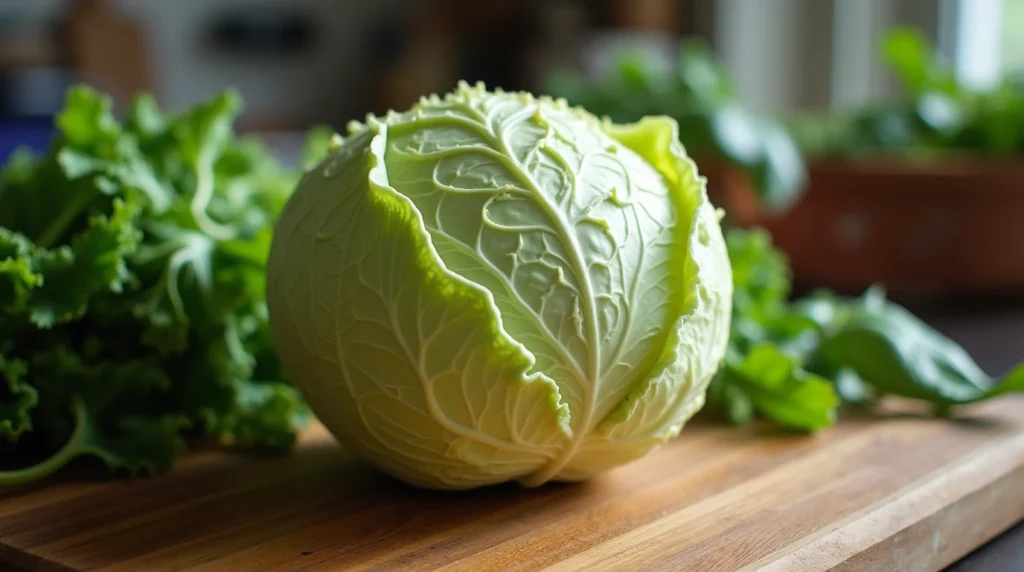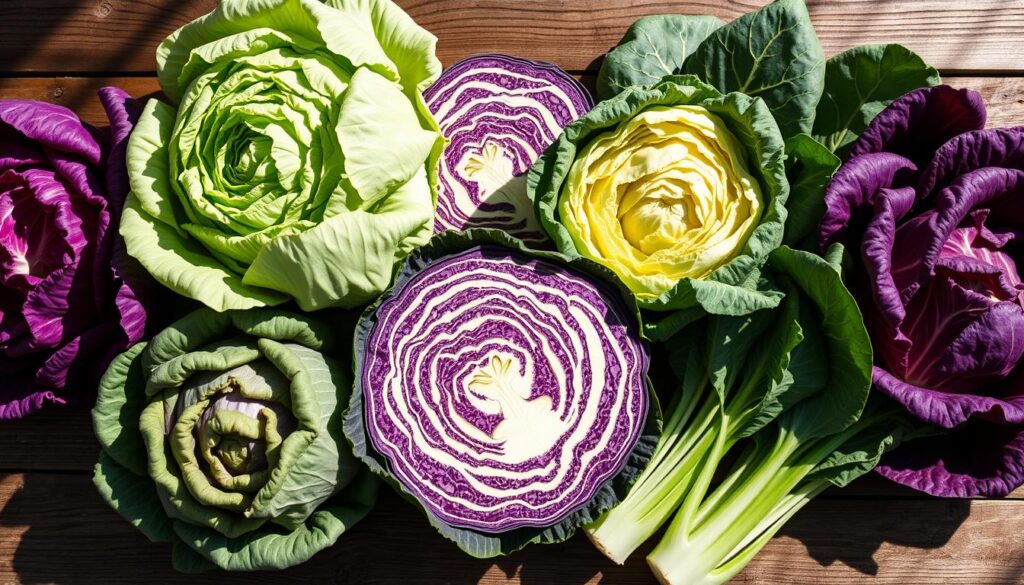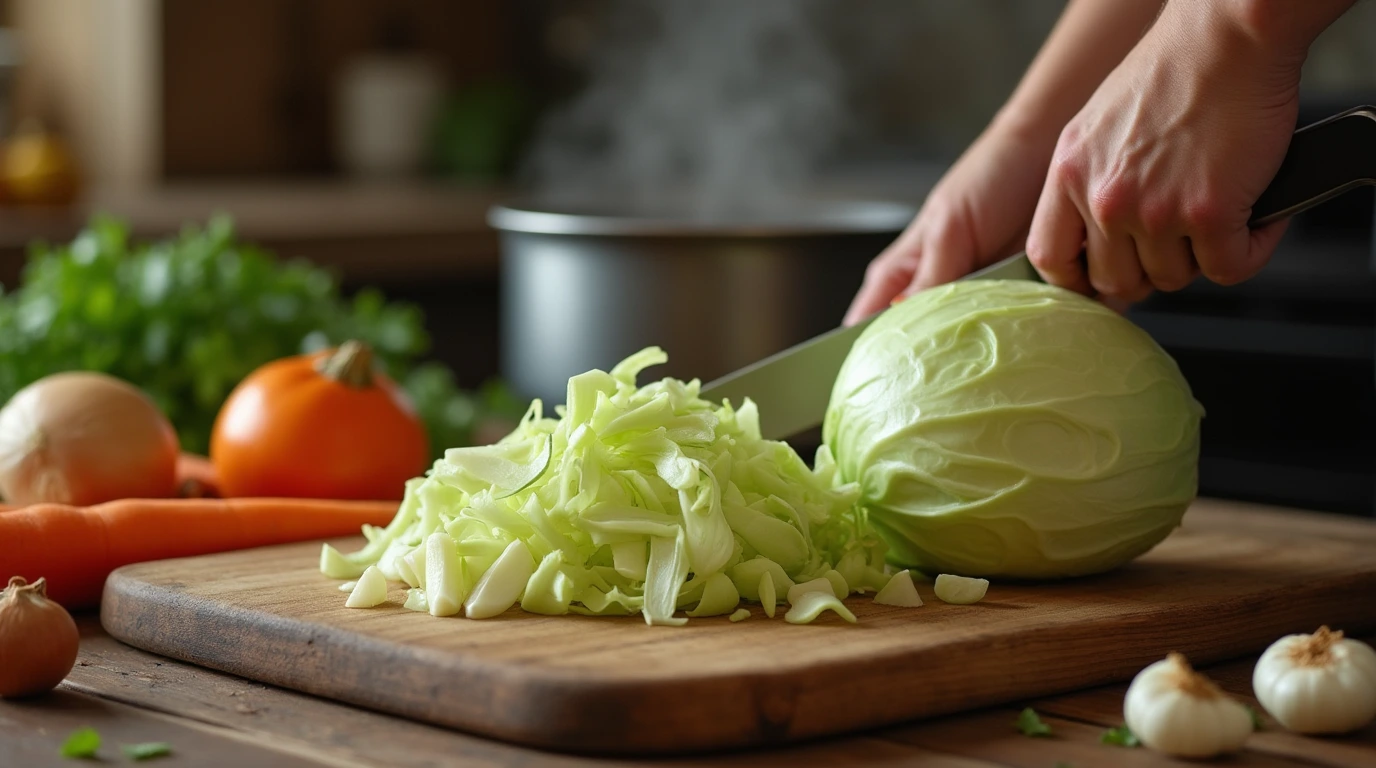Cabbage is a very versatile vegetable. Knowing the best way to cook it can make your dishes much better. Whether you’re making sautéed cabbage or a Southern-style simmered version, it’s key to get it right. Each method, like steaming or boiling, has its own benefits and can highlight different tastes and textures. so what is the best method of cooking cabbage?
In this article, we’ll look at different cabbage recipes and cooking methods. You’ll learn how to make cabbage dishes that are tender and full of flavor. With the right techniques, you’ll be able to enjoy this nutritious vegetable to the fullest.
Introduction to Cooking Cabbage
Cabbage is a favorite in many cuisines, known for its versatility and health benefits. It can be cooked in many ways to bring out its flavor and texture. This makes it a great choice for side dishes.
Whether you boil, steam, or sauté it, cabbage always turns out well. This allows for endless creativity in cooking.
Cabbage is not just good to eat; it’s also full of nutrients. It adds color to your meals and boosts your health. Eating cabbage can give you important vitamins and minerals without adding many calories.
Exploring different ways to cook cabbage opens up new possibilities. It can turn a simple vegetable into a tasty and healthy dish.
In the next parts of this article, we’ll dive deeper into cooking cabbage. We’ll share specific techniques and recipes that showcase its best qualities. You’ll learn how to make quick sautéed dishes and heartier simmered ones. Cooking cabbage is not just about flavor; it’s also about nourishment.

Understanding Cabbage Varieties
Cabbage comes in many varieties, each with its own taste and texture. Knowing about these can make cooking more fun, whether you’re making a salad, stir-fry, or stew. In the US, you’ll often find green, red, and Savoy cabbage in stores. Each type adds something special to different dishes.
Types of Cabbage: Green, Red, and Savoy
Green cabbage is the most common. It has layers of green leaves that look like iceberg lettuce. It’s great for salads and cooking. Red cabbage is smaller and has a deeper color. It tastes slightly peppery and is packed with antioxidants.
Red cabbage turns blue when cooked, if you add something acidic. Savoy cabbage has a milder taste and crinkly leaves. It’s perfect for fresh dishes like wraps or salads. Other varieties like Napa cabbage are also popular. They add color and nutrition to your meals.
Health Benefits of Cabbage
Eating cabbage is good for you. It’s full of vitamins C and K, and fiber. Red cabbage has antioxidants that help fight inflammation. It also has compounds that might help prevent cancer.
Cabbage is also good for your heart. It can lower cholesterol and blood pressure. It’s low in calories and high in water, making it a healthy choice. With over 400 types of cabbage worldwide, trying different ones can make cooking fun and healthy.

What Is the Best Method of Cooking Cabbage?
Choosing the best way to cook cabbage depends on the techniques you know. Each method changes the cabbage’s texture and taste. You can sauté, simmer, boil, or roast it. The right method brings out cabbage’s sweetness and keeps its nutrients.
Sautéing cabbage quickly makes it tender but still crisp. It’s great with many dishes. Boiling cabbage wedges makes them softer, taking about 8 to 10 minutes on each side. Roasting at 425 degrees Fahrenheit for 30 minutes gives crispy edges and a tender core.
Grilling cabbage wedges adds charred flavors in about 30 minutes on medium-high heat. Using an Instant Pot can cook cabbage in 4 to 6 minutes under high pressure. Fermenting cabbage makes dishes like kimchi and sauerkraut, which are good for your gut.
The best way to cook cabbage depends on what you want. Trying different methods can make your meals look and taste better. It also brings out the best in cabbage.
| Cooking Method | Time | Texture | Flavor Notes |
|---|---|---|---|
| Sautéing | 5 minutes | Tender and Crisp | Sweet and Savory |
| Boiling | 8-10 minutes | Soft | Milder Flavor |
| Roasting | 30 minutes | Crispy Edges, Tender Core | Deeply Sweet |
| Grilling | 30 minutes | Charred | Smoky |
| Instant Pot | 4-6 minutes | Variable based on preference | Preserved Natural Flavor |
Sautéed Cabbage: A Quick and Tasty Option
Sautéed cabbage is a quick and tasty way to enjoy this versatile vegetable. It needs just a few ingredients and is flavorful. You can serve it with many main courses. Let’s look at what you need and how to make it.
Ingredients Needed for Sautéed Cabbage
| Ingredient | Quantity |
|---|---|
| Green Cabbage | 1 small head |
| Onion | 1 |
| Garlic Cloves | 2 |
| Ghee (or a blend of butter and olive oil) | 2 tablespoons |
| Salt | To taste |
| Pepper | To taste |
Steps to Make Perfectly Sautéed Cabbage
Start by cutting the cabbage into thin ribbons. Heat ghee or a mix of butter and olive oil in a large skillet over medium heat. Add chopped onion and minced garlic, sautéing until fragrant.
Then, add the cabbage to the pan, making sure it’s evenly spread. Stir occasionally to let it caramelize. This takes about 12 to 15 minutes, until it’s tender and golden.
Season with salt and pepper to taste. For extra flavor, add a splash of apple cider vinegar before serving. This recipe is great as a side dish with chicken, pork, or lamb.
Southern-Style Simmered Cabbage
For those who love rich, comforting flavors, simmered cabbage is perfect. Simmering cabbage gently cooks it, bringing out its natural taste. This method makes Southern cabbage a favorite in many homes.
Why Choose Simmering Over Boiling?
Simmering cabbage is better for flavor lovers. It keeps the cabbage’s texture and flavor, unlike boiling. Boiling can make cabbage mushy. Simmering keeps it tender and ready for seasonings.
Key Ingredients for Flavorful Southern Cabbage
A Southern-style cabbage recipe is all about its ingredients. Start with chopped green cabbage. Use chicken broth, like College Inn, for a rich base. Add 5 slices of bacon, 1 cup of diced onion, and optional smoked turkey or ham hock.
Season with kosher salt, black pepper, granulated garlic, and smoked paprika. These ingredients create a dish that will delight anyone.
Boiled vs. Steamed Cabbage: Which Is Better?
Cabbage is a versatile vegetable with many health benefits. It’s a favorite in many dishes. Boiling and steaming are two main ways to prepare it. Each method affects the cabbage’s texture and taste, changing your meal.
Advantages of Steaming Cabbage
Steaming cabbage keeps more nutrients than boiling. It helps keep vitamins C and K fresh. This method also keeps the cabbage crisp.
Steaming prevents overcooking, which can make cabbage mushy and smelly. You can season it lightly with herbs or spices. This lets its natural sweetness come through.
How to Boil Cabbage Properly
Boiled cabbage is tender and flavorful. Start by cutting it into wedges. Use a big pot of salted water to enhance the taste.
Boil the cabbage until it’s just tender. Be careful not to overcook it, as this can make it smell bad and lose nutrients. Drain the cabbage, then mix it with butter and seasonings for extra flavor.
A simple recipe uses one medium cabbage head, half a teaspoon of salt, and three to four tablespoons of melted unsalted butter.
| Attribute | Steamed Cabbage | Boiled Cabbage |
|---|---|---|
| Nutritional Value | Retains more vitamins | May lose nutrients |
| Texture | Crisp and tender | Soft and tender |
| Cooking Time | Generally quicker | Requires careful timing |
| Flavor | Natural sweetness | Can absorb flavors and seasonings |
Using Broth for Enhanced Flavor
Cooking cabbage with broth adds a new level of taste. This method is popular in Southern cooking, where chicken or vegetable broth makes a big difference. A survey found that 78% of chefs think vegetable broth makes meals taste better.
To make your cabbage dish, start by cooking 1 1/2 onions and 1 bell pepper until the onions are clear. Then, add shredded Savoy cabbage and cook for 15 to 20 minutes on medium heat. The cooking time can change based on how crunchy or soft you like your cabbage.
Using broth not only boosts flavor but also cuts down on sodium. Studies show a 25% less sodium when broth is used instead of salted water. Broth sales for cabbage recipes have gone up by 15% in the last year. People who use broth in their cabbage dishes are 30% happier than those who don’t.
Adding broth to your cooking is more than a trend. It’s a way to make your cabbage recipe more flavorful. With the right ingredients, a simple dish can become a delicious meal.
Cabbage and Egg Recipe Ideas
Cabbage and eggs make for tasty meals that are good for you. They’re perfect for breakfast or brunch, letting you get creative. Mixing cabbage into your favorite recipes brings out the best in both ingredients.
Creative Ways to Combine Cabbage and Eggs
Making a cabbage frittata is a great idea. It only needs eggs and sautéed cabbage. Adding water to the eggs makes them fluffy. You can also add shredded carrots or bell peppers for extra flavor.
Cooking cabbage with eggs adds a nice crunch and taste. It’s a standout dish in the cabbage and egg world.
Popular Cabbage and Egg Dishes
Many cabbage and egg dishes are loved by home cooks. Cabbage pancakes offer a crispy texture and savory taste. Shakshuka with cabbage is another favorite, with its spicy tomato sauce and vibrant veggies.
These dishes show how versatile cabbage is in egg recipes. Each bite is a burst of flavor.
| Dish Name | Main Ingredients | Cooking Time | Calories |
|---|---|---|---|
| Simply Cabbage and Eggs | Cabbage, eggs, olive oil | 10 minutes | 268 kcal |
| Cabbage Pancakes | Cabbage, eggs, flour, seasoning | 15 minutes | 210 kcal |
| Shakshuka with Cabbage | Cabbage, eggs, tomatoes, spices | 20 minutes | 300 kcal |
Serving Suggestions for Cabbage Dishes
Cabbage is a versatile vegetable that can make any meal better. When thinking about serving cabbage, pair it with proteins for a balanced meal. This combo boosts flavor and nutrition, making cabbage a great choice for daily meals.
Complementary Proteins to Pair with Cabbage
Pork chops, grilled chicken, and hearty sandwiches are great with cabbage. Sautéed cabbage goes well with grilled chicken, and roasted pork chops pair nicely with coleslaw. Using ground turkey can make cabbage recipes affordable and tasty.
Creative Cabbage Side Dish Ideas
Make cabbage the main attraction with creative side dishes. Add it to salads or make a refreshing coleslaw for summer. Cabbage steaks offer a unique look, and cabbage in tacos adds a crunchy touch. A big pot of cabbage soup is comforting and perfect for snacks or lunches.
Try cabbage in noodle bowls or slaw-filled sandwiches for something new. Get creative in the kitchen and enjoy the flavors of cabbage!
Storage and Reheating Tips for Cabbage
Cabbage is a tasty and healthy veggie that’s great in many dishes. Keeping it fresh is key to enjoying its flavor and texture. Here are some tips to keep your cooked cabbage delicious when you serve it again.
How to Store Leftover Cabbage
Storing leftover cabbage right keeps it fresh. Put it in an airtight container and chill it fast. Freezing cooked cabbage is also good for up to three months. Remember, one cabbage head gives you about six cups of chopped cabbage, so plan your storage.
Best Ways to Reheat Cabbage Dishes
Reheating cabbage can be done well without losing its quality. Microwaving is a popular choice. Put cabbage in a microwave-safe dish, add a bit of water, and cover it to keep moisture in. You can also reheat it in a skillet on the stovetop. This method heats it evenly, keeping it crisp-tender.
| Method | Time | Notes |
|---|---|---|
| Microwave | 4-6 minutes (chopped) 9-11 minutes (wedges) | Add water to prevent drying |
| Stovetop | 4-6 minutes | Heat gently to avoid overcooking |
| Oven | 20-25 minutes at 375°F | Perfect for large batches |
Cabbage Cooking Mistakes to Avoid
Cooking cabbage is simple, but many make common mistakes. Overcooking is a big one. Boiling it for too long makes it mushy. Cut it thinly for quicker cooking.
Using salt is a great tip for flavor. It makes cabbage taste better and feel softer. Let it sit in salt for an hour before adding dressings.
Storing cabbage right is important. It can last weeks in the fridge. But, washing it first can make it spoil faster. Keep it whole until you’re ready to cook.
Each type of cabbage has its own taste and cooking needs. For example, red cabbage gets a boost from vinegar or lemon juice. Knowing these differences helps avoid mistakes.
Keeping cabbage’s color is hard. For green cabbage, add baking soda to the water. This keeps its color bright. These tips can make your cabbage dishes better.
| Mistake | Effect | Tip to Avoid |
|---|---|---|
| Overcooking | Mushy texture | Limit boiling to 5 minutes |
| Incorrectly Stored | Faster spoilage | Store whole, wash just before use |
| Ignoring Salt | Flat flavor | Salt before resting to draw moisture |
| Inconsistent Cuts | Uneven cooking | Slice uniformly |
| Improper Variety Use | Mismatch in flavor | Choose variety appropriate for dish |
Nutritious Benefits of Cooking Cabbage
Cooked cabbage is packed with nutrients, making it great for a healthy diet. It’s full of vitamins and minerals that boost your health. Vitamin C in cabbage is a big deal, giving you a third of your daily needs in just half a cup.
Vitamins and Minerals Found in Cooked Cabbage
Cooked cabbage is a nutritional powerhouse. It’s low in calories but high in fiber, with 1 gram of fiber for every 10 calories. This helps with digestion and weight control, making it a good choice for health-conscious people.
Studies show eating cabbage often can cut the risk of type 2 diabetes by 38%.
| Nutritional Component | Value per 100 grams |
|---|---|
| Vitamin C | 36.6 mg |
| Fiber | 1 g |
| Vitamin K | 38.2 mcg |
| Potassium | 243 mg |
| Antioxidants | Various compounds |
| Folate | Supports cancer risk reduction |
The glucosinolates in cabbage help fight cancer, thanks to their antioxidant and anti-inflammatory effects. Eating cabbage regularly can reduce inflammation, improving heart health. Plus, cabbage is affordable, costing about 62 cents per pound, or 26 cents per cooked cup. This makes it easy to add to your meals.
Conclusion
Mastering the best ways to cook cabbage can really improve your cooking. This veggie is great for many cooking methods, like sautéing and boiling. These methods bring out its rich flavors and health benefits.
Cabbage is low in calories but high in fiber. It’s also packed with vitamins C and K. Adding ingredients like mustard and smoked paprika can make it even tastier. Plus, you can easily make cabbage dishes vegetarian by skipping the bacon.
Learning how to cook cabbage right helps keep its health benefits. You can enjoy it as a side, in salads, or as a main dish. With these tips, you can try out many delicious cabbage recipes.
FAQ
What is the best way to cook cabbage for maximum flavor?
Cooking cabbage can be done in several ways. Sautéing or simmering brings out its sweetness. Steaming keeps nutrients in. Choose based on your dish.
Can I use different types of cabbage in recipes?
Yes! Each cabbage type—green, red, and Savoy—has its own taste and texture. Green is versatile, red adds color and taste, and Savoy’s leaves add texture. Try different ones in your cooking.
What health benefits does cabbage provide?
Cabbage is packed with vitamins C and K, fiber, and antioxidants. It can help fight inflammation and support digestion. Adding it to your diet boosts overall health.
How do I ensure my sautéed cabbage doesn’t get mushy?
To avoid mushy cabbage, slice it thinly and cook on medium-high. Stir often for even cooking. Add vinegar at the end to boost flavor without overcooking.
Is it possible to infuse cabbage with flavor while cooking?
Yes, using broth instead of water boosts flavor. Chicken or vegetable broth adds depth to your cabbage dishes.
What are some creative cabbage and egg recipe ideas?
Try cabbage frittatas or scrambled eggs with sautéed cabbage for a healthy meal. Cabbage pancakes and shakshuka with cabbage are also tasty. They mix these ingredients in new ways.
How should I store leftover cooked cabbage?
Keep leftover cabbage in an airtight container in the fridge. It lasts up to a week. Cool it first to keep its texture and taste.
What common mistakes should I avoid when cooking cabbage?
Don’t overcook cabbage to avoid mushiness and bad smell. Also, don’t forget to season well. Timing and seasoning are key for great flavor.
What nutritional value does cooked cabbage provide?
Cooked cabbage is rich in vitamins C and K, fiber, and antioxidants. Cooking can make some nutrients easier to absorb. It’s a great addition to your meals.

